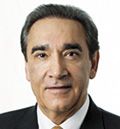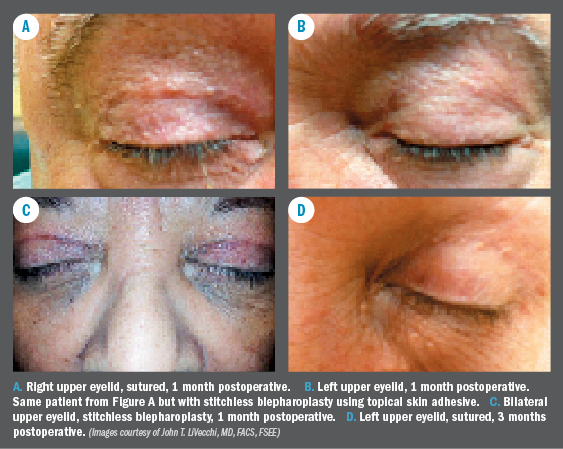Article
A surgeon’s pursuit of sutureless blepharoplasty
A stitch-less blepharoplasty procedure is possible with use of a new topical skin adhesive.
Take-home
A stitch-less blepharoplasty procedure is possible with use of a new topical skin adhesive.

Dr. LiVecchi
Plastics Pearls By John T. LiVecchi, MD, FACS, FSEE
As ophthalmic surgery continues to evolve, myriad improvements have been made to small-incision cataract surgery and sutureless cataract surgery, resulting in enhanced surgical outcomes. Why not sutureless blepharoplasty?
This is the consideration I have applied to blepharoplasty and other oculoplastic procedures. If the procedure could be done faster without compromising outcomes, then why not? If the incision can be closed faster with a topical skin adhesive and also provide a microbial barrier, so much the better. Could topical skin adhesives also improve cosmesis in the ever-critical aesthetic procedure market?

These are some questions considered in a quest to improve one of the specialties’ most commonly performed procedures, the blepharoplasty.
Use of adhesive
Topical skin adhesives have been around for many years, but until the advent of 2-octyl cyanoacrylate iterations, they were too brittle and exothermic for most oculoplastic procedures. That has changed with the development of a new topical skin adhesive (SurgiSeal, Adhezion Biomedical).
In case you missed it: An Attack on Elite Educational Institutions
This adhesive is stronger, more flexible, and dries faster than other 2-octyl cyanoacrylate adhesives. When dry, the adhesive has the effective strength of a 5.0 suture or 10 days of healing. The adhesive also provides a waterproof microbial barrier, greatly reducing the chance of postoperative infection and eliminating the need for antibiotic ointments during the entire postoperative period. As an additional benefit of this new adhesive, the patient can shower the same day of surgery.
Historical perspective
Twenty years ago, I decided to use “crazy glue” in a few routine procedures performed to enhance results or aide in procedures in other ways.
For instance, when performing a dacryocystorhinostomy in conjunction with silicone intubation, there would be occasions when the patient would inadvertently and prematurely unravel or pull out the silicone stent completely from the nose. In order to prevent this, a drop of crazy glue was added to the silicone stent knot at the end of every case to solve the problem.
In another example, the glue was used as a temporary tarsorrhaphy in children who were uncooperative. The idea for this came from observing cases with children who were playing with the glue and splashed their eyelids closed. It was sometimes easier to leave the glue on the screaming kids’ eyelids rather than traumatize them further-and at the same time avoid heart failure of the parents as they watched their child being pinned down by two technicians-while I was picking off the glue.
Of course, a ragged edge of the glue that may be in contact with the eye was first ruled out. I also used it on adults to save time and suturing, knowing that in about 10 days time it will be all gone on its own.
I also liked using it for stab incisions for ptosis-sling procedures. This allowed me to be very secure and confident that the probability of an infection was close to zero with its protective barrier.
Necessity as mother of invention
The question arose in my mind two decades ago about whether or not to glue blepharoplasty incisions. The difference with eyelids was that they were in constant motion from blinking all day long as compared with the other sites where adhesives were used, which for the most part were relatively static.
I also had tried using medical grade glue that existed back but abandoned its use for several reasons. The glue cured too lumpy from the lack of a good application process. It was too brittle and took too long to dry. In addition, the wound edges could not be seen to determine if there was proper opposition, from the thick glue lumpiness and the bleeding that occurred between the skin-glue plain.
Twenty years later, this new topical skin adhesive resolved those issues with a specific applicator unique for the use in blepharoplasty.
Upon studying the safety and efficacy claims of this adhesive, I performed an initial series of 20 sutureless blepharoplasty cases, or 40 eyes. Everything in the blepharoplasty procedure is standard procedure, until incision closure occurs.
The training required for application of the adhesive was straightforward. Though specific, it was much easier and less time consuming than suturing. It involved wound drying, wound approximation, and a two-layer application of adhesive. The first application is applied for about 30 seconds of dry time, and then the second application is applied for the final 30 seconds of dry time. In a total of about 2 minutes the closure was the equivalent of 6.0 suture or 10 days of healing.
In the initial case, two to three temporary sutures were placed at the incision site for approximation. The sutures were removed after the adhesive cured, in accordance with directions, where the temporary sutures were placed. The surgical sites were observed to have negligible wound gape and no dehiscence, resulting in sutureless blepharoplasty or no-stitch blepharoplasty.
Now, I have observed more than 100 eyes with this sutureless blepharoplasty experience and am confident in the procedure’s benefit. Subsequent to the initial sutured procedure, temporary sutures have not been used as both confidence and technique have evolved. However, that it would be prudent for surgeons to use the temporary sutures until they are confident in their ability to close with this topical skin adhesive and approximate at the same time.
It is important to note that no adverse reactions or infections have been experienced, but instead good wound closure. Time is saved by using this adhesive, as opposed to placing a long running suture-with the average cost for operating room time in the $60/minute range.
With the added benefit of a microbial barrier, the chances for infection are greatly reduced.
From a patient’s perspective, when asked if they had a preference of having an incision closed with surgical glue or suture, the response was almost unanimous in favor of glue. When patients are seen postoperatively the next day they have reported that they like not needing sutures removed. This adhesive comes off by itself in 5 to 10 days, as normal re-epithelialization takes place.
Sutures a thing of past?
In the quest for a better blepharoplasty, suture tracks are a thing of the past. Healing is probably accelerated by reducing the further inflammatory result from the insult of needles passing through with the suture and the suture itself.
Common sense is encouraged when selecting patients for stitchless blepharoplasty. Potential patient compliance and the ability to recognize early dementia-like conditions are crucial for successful outcomes.
The sutureless blepharoplasty technique involves a learning curve and some initial apprehension that is well founded. Fortunately, the adhesive had already been used on hundreds of thousands of wound-closure events-general surgery, plastic surgery, orthopedic surgery, trauma surgery, and the basic tenants for most effective wound/incision closure were well demonstrated.
It is important to note that although the blepharoplasty procedure is not changed until closure occurs, at closure the wound edges should be as dry and as blood-free as possible to ensure superior closure.
When the incision is approximated, the adhesive is applied to the length of the incision via the pen-like applicator. The surgeon goes over the incision with glue, and by virtue of the wide applicator forms a bridge of adhesive creating the bond that holds the tissue edges together. At this time the surgeon must keep the edges approximated while the adhesive cures, which is about 30 seconds for the first application.
Next, with the incision already approximated, the surgeon applies another layer of adhesive and waits about 30 seconds or when the layer of the adhesive is completed on the contralateral eyelid. At this juncture, surgical efforts are secure. Certainly, extra caution needs to be exercised regarding keeping adhesive away from eyelid margins and eyelashes, as the tissue exposed will be glued.
Surgeons should be conscientious that even though they have reduced time, reduced infection, and improved cosmesis, they are still performing surgery and it remains very specific. Any lack of attention to changes in a procedure can create unwanted challenges, and add time to an otherwise improved procedure.
In a 30-year ophthalmic journey and after having performed more than 25,000 oculoplastic procedures, great advances have occurred in cataract surgery, refractive surgery, and posterior segment surgery. In a quest to improve outcomes and efficiency in the oculoplastic surgery realm, it is clear that a significant advance in technique is being refined.
When selective and appropriate patients are chosen, I am confident that we have reduced the time to perform a blepharoplasty, without compromising the integrity of the incision. We have reduced the opportunity of infection, eliminated the need for antibiotic ointments postoperatively, and improved cosmesis. Most importantly, patients are delighted with the results.
John T. LiVecchi, MD, FACS, FSEE, is assistant clinical professor of ophthalmology at Drexel University College of Medicine, Philadelphia and the University of Central Florida College of Medicine, Orlando. Dr. LiVecchi is in private practice and director of oculoplastics at the Lange Eye Institute. Dr. LiVecchi has no financial interest. Dr. LiVecchi wishes to credit Jim Simms, who helped him design the new tissue adhesive applicator.
Newsletter
Don’t miss out—get Ophthalmology Times updates on the latest clinical advancements and expert interviews, straight to your inbox.




